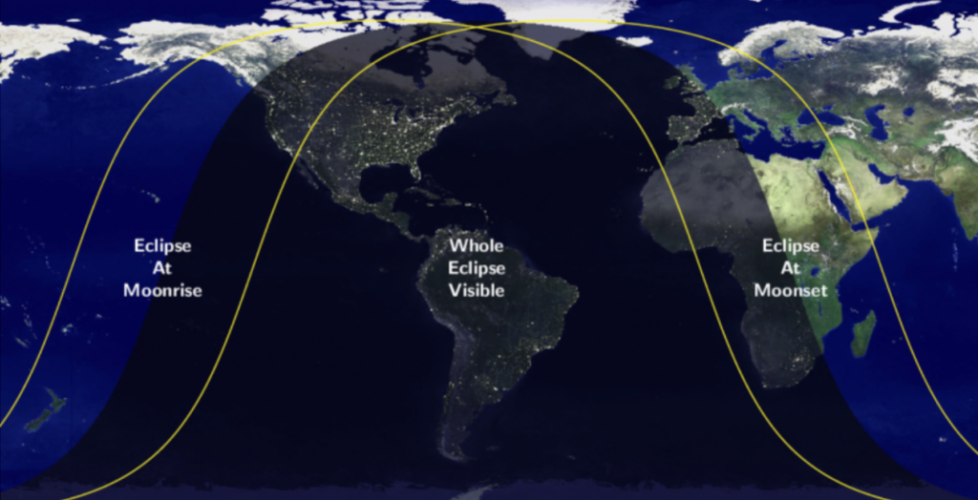Total Lunar Eclipse, May 15-16, 2022
On Sunday evening/night, May 15, there will be a total lunar eclipse (when the Moon goes into Earth’s shadow). Weather permitting, everyone on Earth’s dark (night) side will be able to see it. The eclipse will occur in the eastern evening sky, shortly *after* sunset, as seen from the western continental United States and western Canada. It will be high in the sky at various times around the middle of the night in the eastern United States and Canada, Mexico, Central America, and South America. The total eclipse will not be visible from Hawaii, but the Moon will be partially eclipsed at moonrise (which occurs at sunset). In Spain and western Africa, the total eclipse will be visible before moonset in the western morning sky (Monday, May 16), shortly before sunrise. See the attached map, courtesy Dominic Ford from in-the-sky.org. Also, consult the excellent website https://www.timeanddate.com/eclipse/lunar/2022-may-16 for a detailed map and the ability to see whether the eclipse will be visible from a specific location (put your location in the “Eclipse Lookup” box on the right-hand side of the web page).
Totality will last about 1 hour 24 minutes, a relatively long total lunar eclipse (because part of the Moon will pass through the center of Earth’s shadow). Unlike the case in a total *solar* eclipse, the lunar eclipse will occur at the same time (after adjusting for time zones) from any location where it is visible. No optical aid is needed — just use your eyes (though the view through binoculars should be interesting as well).
Here are the relevant times in San Francisco, CA; adjust for your time zone if you will be away from Pacific Daylight Time (PDT). (For example, mid-eclipse will be at 12:11 am EDT on May 16, as viewed from the USA’s east coast that’s Sunday night, but technically Monday early morning.)
Partial eclipse begins: 7:27 pm PDT Sunday, May 15 (below the eastern horizon)
Moonrise: 8:06 pm PDT (You will need a very clear, low, eastern horizon to see it.)
Total eclipse begins: 8:29 pm PDT
Mid-eclipse: 9:11 pm PDT
Total eclipse ends: 9:53 pm PDT
Partial eclipse ends: 10:55 pm PDT
“Prime time” (total eclipse) will be 8:29-9:53 pm PDT. The Moon will be east, low over the horizon, shortly after it rises; try to avoid obstructions like mountains, buildings, and trees. The farther east you are in the continental United States, the farther above the horizon the Moon will be.
Again, for more information see https://www.timeanddate.com/eclipse/lunar/2022-may-16 .
Another good website is https://earthsky.org/astronomy-essentials/total-lunar-eclipse-may16-2022/ .
Wishing you clear skies during the night of May 15/16, 2022,
Alex
*****
Additional details:
The Moon doesn’t appear completely dark during a total lunar eclipse because some sunlight goes through Earth’s atmosphere and is bent (refracted) toward the Moon, and then it bounces off the Moon back toward us. But the Moon’s color generally appears some shade of yellow, orange, or even red because the light that reaches it has been filtered by Earth’s atmosphere, preferentially getting rid of the violet, blue, and green colors — just as in the case of the setting or rising Sun, which looks some shade of yellow, orange, or red, depending on the amount of particular matter (such as smoke) in the atmosphere. I expect that on May 15/16, the Moon will look pretty dark (though still orange/red) at mid-eclipse, because it will be deep in Earth’s shadow.
Also, on May 15/16 the full moon will be a little closer to Earth than average in its elliptical orbit and therefore look a bit bigger — a “Super Moon” (or “Supermoon”). But in my opinion, this is often exaggerated by the press; though the Moon isnearly at its closest to Earth in its elliptical orbit, even the best Super Moon looks only slightly bigger (6-7%) and brighter (12-14%) than an average full moon. Also, “Super Moons” are pretty common; in fact, there are three in 2022. Since the totally eclipse Moon can appear reddish orange, it is sometimes called a “Blood Moon,” so this particular eclipse will be a “Super Blood Moon.”
Note that during the partial phases, Earth’s shadow on the Moon looks distinctly curved. This is *always* the case during a lunar eclipse, and it was one of the many pieces of evidence that the ancients used to conclude Earth is round, not flat.
In the above list of times, I didn’t include the “penumbral” eclipse, when Earth blocks only *part* of the Sun as seen from the Moon; the full moon will look slightly fainter during the penumbral eclipse, but this effect is hard to notice and isn’t very interesting. It begins at 6:32 pm PDT (before moonrise in the PDT time zone) and ends at 11:50 pm PDT.

